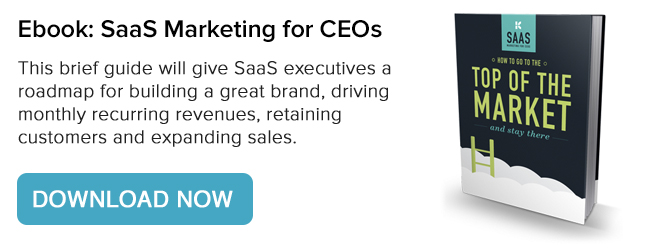
According to Gartner, the market for SaaS (Software as a Service) applications will grow from $20 billion in 2013 to $33 billion in 2016, with a compound annual growth rate of 19.5%. A Compass study shows that SaaS is growing nearly 3X as fast as software as a whole, and that 72% of all SaaS startups are at least partially funded.
Good news for SaaS startups and growing SaaS ventures alike, but the space is getting crowded and competition is fierce. What can founders and executives do to improve the odds that their companies will get to the top of the market and stay there?
The SaaS Challenge
For most SaaS CEOs, the problem isn’t opportunity; it’s time. From startup to break-even, your company is under the gun to grow monthly recurring revenues fast enough to offset (and pay back) customer acquisition costs and churn before the funding well runs dry. David Skok calls this deficit the “cash flow gap.”
The success or failure of early stage SaaS companies depends on their ability to:
- Acquire new customers quickly and cost effectively
- Retain customers over the long haul
- Upsell customers to increase LTV over time
What Can You Do to Build Your Customer Base Quickly?
Let’s start with your product. Successful SaaS companies like Salesforce or Shopify don’t just invent something unique or cool.
They build products that their customers love.
They do that by getting to know their customers before trying to sell to them. They also solve BIG problems that their customers have. In the case of Salesforce, they made it much easier to manage Sales by inventing the first cloud-based CRM. Shopify did the same thing with e-commerce, creating an affordable platform for small businesses selling online. Others, like HubSpot, wanted to revolutionize marketing through attraction rather than interruption, so they invented inbound marketing.
Now, let’s get to the heart of the SaaS challenge. Assuming you have developed a great product that your customers will love, you have to get to market fast, generate revenues quickly and get to break-even before your seed capital runs out and you go belly up.
Successful SaaS companies use a blend of inbound marketing, influencer marketing and “growth hacking”, in which they leverage developer and user communities to test the product, help design it and promote it through their networks. What’s in it for them? In many cases, these brand advocates are rewarded directly with sales commissions or become resellers or channel partners, and they can build their businesses based on those relationships. Shopify, for example, created both a Shopify Expert marketplace for promoting freelancers and a Partner program for agencies.
What About CAC and LTV?
Next on the challenge list is customer acquisition cost (CAC). If you burn through your seed capital with lots of expensive ads and hire a bunch of sales reps to make cold calls, you will find it hard to survive for long. What do successful SaaS companies do? They leverage inbound marketing to find qualified leads, then hook them up with helpful inside sales reps who act more like consultants. Close rates go up and cost-per-lead goes down.
Last but not least, customer lifetime value (LTV). The name of the game in SaaS is monthly recurring revenues over (hopefully) a long period of time. This is how you overcome CAC costs and start driving profitability. There are two aspects to maximizing LTV, minimizing churn and upselling.
Successful SaaS companies build educational resources that help users learn best practices, stay current with new features and get the most out of their software investment. HubSpot, for example, created HubSpot Academy with a certification program that helps keep users on top of their game while earning street cred (and resume enhancement) by becoming acknowledged experts. Successful companies also sponsor local user groups to discuss issues and best practices.
All of this, plus customer support and services from both internal staff and Partner networks, keeps users happy and retained. As the love spreads within a customer account, more licenses are sold and new features, such as the new CRM, are added to further increase LTV. Everybody wins.
The Secret Sauce of Successful SaaS Companies
It’s pretty simple really. Successful Saas companies do marketing right. They are crushing it because they believe in what they are doing, they hire great people and they continue to make the investments in customer happiness that drive both revenues and profitability. The challenge for most entrepreneurs and early-stage SaaS companies is understanding how to get started with inbound marketing, content marketing, influencer marketing, social media marketing and levels of customer service required to attract and support users and turn them into brand advocates. How much does it cost and when does each component come into play?
We’ve just released our SaaS Marketing for CEOs eBook to help you reach your growth goals by learning from the best of the best and practicing what they preach. We tell the story of Shopify, because they were doing inbound before it was cool. We dive into the details of how Shopify started and continues to dominate their market by forging relationships with small businesses through blogging and channel partnerships. We hope you enjoy the eBook, and we look forward to continuing the conversation with you as you build your SaaS company.
![]()







